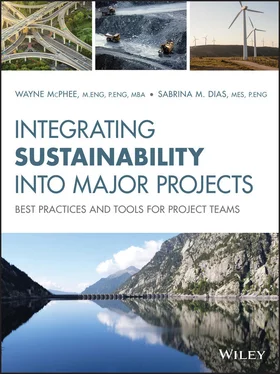1.3 Creating a Sustainability Focus 1.3 Creating a Sustainability Focus There are a number of different ways to think about sustainability. Some people understand sustainability to be only about renewable energy or green buildings. Others think sustainability is about engaging with the local community or philanthropic donations to a local charity. In our approach we think about sustainability as a focus on creating the maximum positive impact and the minimum negative impact from a project. This goes beyond meeting regulatory requirements and involves all elements of the project. This section examines some of the models that the project team can use to create a sustainability focus across the entire project. We look at the evolution of organizations from being compliance focused to being sustainability focused, how project teams can focus on managing sustainability, and how to think about complexity and social capital.
1.4 Sustainability Is a Team Sport 1.4 Sustainability Is a Team Sport As managing sustainability becomes increasingly important to project success and the complexity of meeting such targets increases, sustainability must be embraced by all members of the project team. It cannot be delegated to a separate sustainability department or completely outsourced to external consultants. Meeting sustainability goals and creating a better project requires input from every member of the team and every person on a project. Figure 1.3 Sustainability as a team sport. The diagram in Figure 1.3 shows how sustainability can fit into the entire project. Each department can influence sustainability issues and have a positive effect on the project. The diagram is by no means complete and will change from project to project but shows how sustainability is truly a team sport and not just the responsibility of the sustainability team. It is also important to remember that sustainability issues are not specific to one group or department. In many cases, more than one group across the project team may need to be involved to have an influence on activities and issues. Take, for instance, providing training and skills development to the local community in order to increase the opportunity to hire as many local workers as possible. This objective can be influenced by: Human resources, which develops training programs Construction management, which runs the job training Health and safety, which gets involved in improved health or safety training Procurement, which incorporates training requirements into contractor Request for Proposals (RFPs) and contracts Indigenous affairs, which ensures local indigenous communities get training in transferable skills that create benefits for the community Project controls, which would be tasked with tracking training metrics as part of project key performance indicators (KPIs) One effective way to create the sustainable team sport diagram for your project team is to hold a series of meetings with each of the departments or groups to discuss the basic concept and overall project sustainability objectives. Each group is then encouraged to find creative ways that they can contribute to the sustainability of the project.
1.5 Who Is This Book For? 1.5 Who Is This Book For? With the rapidly changing social and environmental responsibilities that major projects are facing, project teams need to have the background knowledge, strategic insights, and skills to ensure that their organization is proactively managing sustainability. This book is intended for the project leadership team responsible for all aspects of the project, the sustainability team responsible for managing the project's sustainability program, and for the entire project team involved in delivering aspects of the sustainability program. This book will help everyone involved in the delivery of major projects, including: Project owners who want to manage risks and optimize project value Project directors and managers responsible for creating a successful project that meets budget, schedule, and sustainability objectives Engineering discipline leads and teams tasked with creating designs Procurement teams responsible for bringing the best contractors and suppliers to the project Construction management teams that want to ensure their workforce is engaged and that there are no unexpected delays in their schedule Sustainability, environment, and communications teams that want to improve their engagement with the entire project team Financing agencies that want to ensure the projects they invest in can manage risks, achieve institutional requirements, and deliver projects that will not make the news and damage the financial institute's brand Consultants and contractors who need to understand how their work can support the project team with delivering a successful project Government regulators who want to understand the challenges of delivering major projects Students who are looking for careers in project management and project delivery Although this book is intended for major development projects, many of the processes and tools are also helpful for smaller projects. For example, the decision support tools are useful for upgrades to operating facilities and corporate decision making.
1.6 How to Use This Book Endnotes
5 CHAPTER 2: Overview of Major Projects 2.1 What Is a Major Project? 2.2 Types of Major Projects 2.3 Types of Project Structures 2.4 Key Players 2.5 Managing Time and Space 2.6 Project Lifecycle 2.7 Summary
6 CHAPTER 3: Standards and Guidelines 3.1 Getting Started 3.2 International Standards and Guidelines 3.3 Industry Guidelines 3.4 Discipline Guidelines 3.5 Responsible Project Financing 3.6 Sustainable and Responsible Investing 3.7 Managing Standards and Guidelines 3.8 Summary Endnotes
7 CHAPTER 4: Understanding What Is Important 4.1 Mapping Sustainability Topics 4.2 Mapping External Factors 4.3 Value Chain Analysis 4.4 Focus on Materiality 4.5 Summary Endnotes
8 CHAPTER 5: Project Management 5.1 Sustainability Steering Committee 5.2 Project Charter 5.3 Sustainability Policy 5.4 Project Goals 5.5 Structuring the Project Organization 5.6 Project Execution Plan 5.7 Project Schedule 5.8 Project Communications Plan 5.9 Change Management 5.10 Project Team Roles and Responsibilities 5.11 Summary
9 CHAPTER 6: Stakeholder Engagement 6.1 Reasons to Engage 6.2 Identifying Stakeholders 6.3 Understanding Project Stakeholders 6.4 Engaging 6.5 Documenting Engagement 6.6 Communicating 6.7 The Stakeholder Engagement Plan (SEP) 6.8 Community Agreements 6.9 Additional Tools 6.10 Summary Endnote
10 CHAPTER 7: Managing Risk and Opportunity 7.1 Risk Workshops 7.2 Project Risk Register 7.3 Risk Management Plans 7.4 Opportunity Management 7.5 Summary
11 CHAPTER 8: Sustainability Management Tools 8.1 Sustainability Integration Framework 8.2 Management Systems 8.3 Managing Commitments 8.4 Developing a Commitments Action Log 8.5 Managing Complaints 8.6 Developing a Complaint Mechanism 8.7 Monitoring Sustainability Performance 8.8 Summary Endnotes
12 CHAPTER 9: Approvals and Permits 9.1 Approvals 9.2 Permits 9.3 Summary
13 CHAPTER 10: Design 10.1 Design Basis 10.2 Selecting a Location 10.3 Community Design Workshops 10.4 Innovation 10.5 Decision Making 10.6 Designing for Climate Change 10.7 Summary Endnotes
14 CHAPTER 11: Procurement 11.1 Procurement Plan 11.2 Economic Development Plan 11.3 Equipment and Materials 11.4 Supplies and Services 11.5 Logistics 11.6 Contractors 11.7 Summary Endnotes
15 CHAPTER 12: Construction Management 12.1 Transition to Construction 12.2 Stakeholder Communications During Construction 12.3 Public Safety 12.4 Environmental Management 12.5 Working with Contractors 12.6 Permit to Work System 12.7 Construction Sustainability Metrics 12.8 Creating a Sustainability Culture 12.9 Summary Endnote
16 CHAPTER 13: Commissioning 13.1 Commissioning Team 13.2 Management Systems 13.3 Stakeholder Engagement 13.4 Communications 13.5 Completion and Demobilization 13.6 Summary
Читать дальше












